Exploring Evidence-Based Learning in Health and Social Care Settings
VerifiedAdded on 2023/06/13
|11
|3991
|361
Essay
AI Summary
This essay provides an overview of evidence-based learning in health and social care, focusing on the application of qualitative and quantitative research methods. It discusses the characteristics of both research types, including data gathering methods such as experiments, surveys, literature reviews, and interviews. The essay also addresses the importance of reliability and validity in research, emphasizing their roles in ensuring the quality of investigation and the accuracy of measurements. Furthermore, it explores the relationship between research theory and health and social care practice, highlighting how clinical practices generate research questions and how research guides clinical practices and builds knowledge through theory improvement. The essay also presents evidence from various research sources, including a comparison of fractional flow reserve (FFR) guided PCI (Percutaneous Coronary Intervention) and coronary artery bypass surgery (CABS), concluding with the benefits of PCI in decreasing heart illness.

Evidence based learning in health and
social care.
social care.
Paraphrase This Document
Need a fresh take? Get an instant paraphrase of this document with our AI Paraphraser

Table of Content.
INTRODUCTION...........................................................................................................................1
MAIN BODY...................................................................................................................................1
CONCLUSION................................................................................................................................1
REFERENCES................................................................................................................................2
INTRODUCTION...........................................................................................................................1
MAIN BODY...................................................................................................................................1
CONCLUSION................................................................................................................................1
REFERENCES................................................................................................................................2

INTRODUCTION
The concept of health and social care is generally a treatment towards the ill well-being
and a medical condition within the healthcare organizations, the well-being centres as well as
within community as well. In this, social care is generally a care and support of the vulnerable
people, more commonly within a community. A coronary bypass surgery is generally a
procedure which can restores the flow of blood to the cardiac muscles by simply diverting the
blood flow around the sections of a blocked artery within cardiac system. The bypass surgery can
significantly redirect the blood around sections of a blocked or the partially blocked artery within
human cardiac system. In this, a fractional flow reserve (FFR) is generally a pressure wire-based
index which is specifically used during the coronary angiography in order to measure the
potential of the coronary stenosis in order to cause the myocardial ischaemia. In this research, it
will cover a comparison of two chosen articles qualitative and quantitative both within an area of
fractional flow reserve (FFR) guided PCI (Percutaneous Coronary Intervention) as related with
coronary artery bypass surgery (CABS) (Fearon and et.al., 2022).
MAIN BODY
Identify characteristics of qualitative and quantitative research methods.
When conducting research, the collection as well as analysis of information can be in the
form of both quantitative and qualitative as well. While talking about the quantitative research, it
generally deals with figures, statistics as well as the numbers and while talking about qualitative
research, it specifically deals with meanings and words. These both types of research are quite
essential for gaining the various kinds of knowledge. In contrast with quantitative research, it is
expressed in the in both the graphs as well as numbers. The quantitative research type is
generally used to test or can confirm the assumptions as well as theories. The research type is
specifically used to establish the more generalize facts about the particular topic. In this, the
more common quantitative methods can involve observations, experiments that are recorded in
the form of figures, numbers as well as the surveys with closed-ended questions. The quantitative
research types are generally concentrated over the testing theories as well as hypothesis and can
needs various participants to analyse the research more deeply. In addition to this, the key terms
that are mainly used within this type of research can include measurements, replicability,
objectivity and many more. In contrast with qualitative research types, these are mainly
1
The concept of health and social care is generally a treatment towards the ill well-being
and a medical condition within the healthcare organizations, the well-being centres as well as
within community as well. In this, social care is generally a care and support of the vulnerable
people, more commonly within a community. A coronary bypass surgery is generally a
procedure which can restores the flow of blood to the cardiac muscles by simply diverting the
blood flow around the sections of a blocked artery within cardiac system. The bypass surgery can
significantly redirect the blood around sections of a blocked or the partially blocked artery within
human cardiac system. In this, a fractional flow reserve (FFR) is generally a pressure wire-based
index which is specifically used during the coronary angiography in order to measure the
potential of the coronary stenosis in order to cause the myocardial ischaemia. In this research, it
will cover a comparison of two chosen articles qualitative and quantitative both within an area of
fractional flow reserve (FFR) guided PCI (Percutaneous Coronary Intervention) as related with
coronary artery bypass surgery (CABS) (Fearon and et.al., 2022).
MAIN BODY
Identify characteristics of qualitative and quantitative research methods.
When conducting research, the collection as well as analysis of information can be in the
form of both quantitative and qualitative as well. While talking about the quantitative research, it
generally deals with figures, statistics as well as the numbers and while talking about qualitative
research, it specifically deals with meanings and words. These both types of research are quite
essential for gaining the various kinds of knowledge. In contrast with quantitative research, it is
expressed in the in both the graphs as well as numbers. The quantitative research type is
generally used to test or can confirm the assumptions as well as theories. The research type is
specifically used to establish the more generalize facts about the particular topic. In this, the
more common quantitative methods can involve observations, experiments that are recorded in
the form of figures, numbers as well as the surveys with closed-ended questions. The quantitative
research types are generally concentrated over the testing theories as well as hypothesis and can
needs various participants to analyse the research more deeply. In addition to this, the key terms
that are mainly used within this type of research can include measurements, replicability,
objectivity and many more. In contrast with qualitative research types, these are mainly
1
⊘ This is a preview!⊘
Do you want full access?
Subscribe today to unlock all pages.

Trusted by 1+ million students worldwide

expressed in the form of words. The research type is significantly used to gain knowledge or
understand the particular concepts, experiences and thoughts as well. it can allow the researcher
to collect an in-depth insight on the specific topics which are not well understood. In this, the
most common qualitative methods that is involved an interview with open-ended questions,
literature review which can expand the particular theories and concepts, the observations that are
described in words. While doing the qualitative research, it does not need more participants and
the key terms that are mostly used in the qualitative research can involve such as complexity,
understanding, subjectivity and contexts as well (Anyon, Bender, Kennedy and Dechants, 2018).
Information gathering methods in Quantitative research:
Experiments: The situations in which the variables are manipulated as well as controlled in order
to create the cause-and-effect relationships.
Surveys: It can involve the list of multiple or closed type questions which are dispersed to a trial
(Online, in a person or over the system).
Observations: In this, the detecting subjects within a normal environment where the variable
quantity cannot be controlled.
Information gathering methods in Qualitative research:
Literature review: The literature review can involve the survey of the published works by the
other authors.
Interviews: It can involve asking the open-ended questions verbally to the participants.
Ethnography: In this, it can involve participating within a community or a workplace for an
extended periods of the time to more closely observe the behaviour and culture as well.
Focus groups: In this, it can involve the discussion among the groups of people about a topic in
order to collect the opinions which can be used for additional investigation.
Reflect research evidence appropriate to the health and social care practice considering reliability
and validity.
The concept of dependability and validity are generally the two thoroughly related topics.
But they mean the different things. In this, a dimension can be reliable but without being valid.
Therefore, if a dimension is valid, it is usually also reliable. These both concepts are used in
order to measure the quality of the investigation. these can point how well a method, technique
or test measure something. In addition to this, reliability is generally about uniformity of a
measure, and a validity is about the quality of a measure. While conducting research, it is crucial
2
understand the particular concepts, experiences and thoughts as well. it can allow the researcher
to collect an in-depth insight on the specific topics which are not well understood. In this, the
most common qualitative methods that is involved an interview with open-ended questions,
literature review which can expand the particular theories and concepts, the observations that are
described in words. While doing the qualitative research, it does not need more participants and
the key terms that are mostly used in the qualitative research can involve such as complexity,
understanding, subjectivity and contexts as well (Anyon, Bender, Kennedy and Dechants, 2018).
Information gathering methods in Quantitative research:
Experiments: The situations in which the variables are manipulated as well as controlled in order
to create the cause-and-effect relationships.
Surveys: It can involve the list of multiple or closed type questions which are dispersed to a trial
(Online, in a person or over the system).
Observations: In this, the detecting subjects within a normal environment where the variable
quantity cannot be controlled.
Information gathering methods in Qualitative research:
Literature review: The literature review can involve the survey of the published works by the
other authors.
Interviews: It can involve asking the open-ended questions verbally to the participants.
Ethnography: In this, it can involve participating within a community or a workplace for an
extended periods of the time to more closely observe the behaviour and culture as well.
Focus groups: In this, it can involve the discussion among the groups of people about a topic in
order to collect the opinions which can be used for additional investigation.
Reflect research evidence appropriate to the health and social care practice considering reliability
and validity.
The concept of dependability and validity are generally the two thoroughly related topics.
But they mean the different things. In this, a dimension can be reliable but without being valid.
Therefore, if a dimension is valid, it is usually also reliable. These both concepts are used in
order to measure the quality of the investigation. these can point how well a method, technique
or test measure something. In addition to this, reliability is generally about uniformity of a
measure, and a validity is about the quality of a measure. While conducting research, it is crucial
2
Paraphrase This Document
Need a fresh take? Get an instant paraphrase of this document with our AI Paraphraser
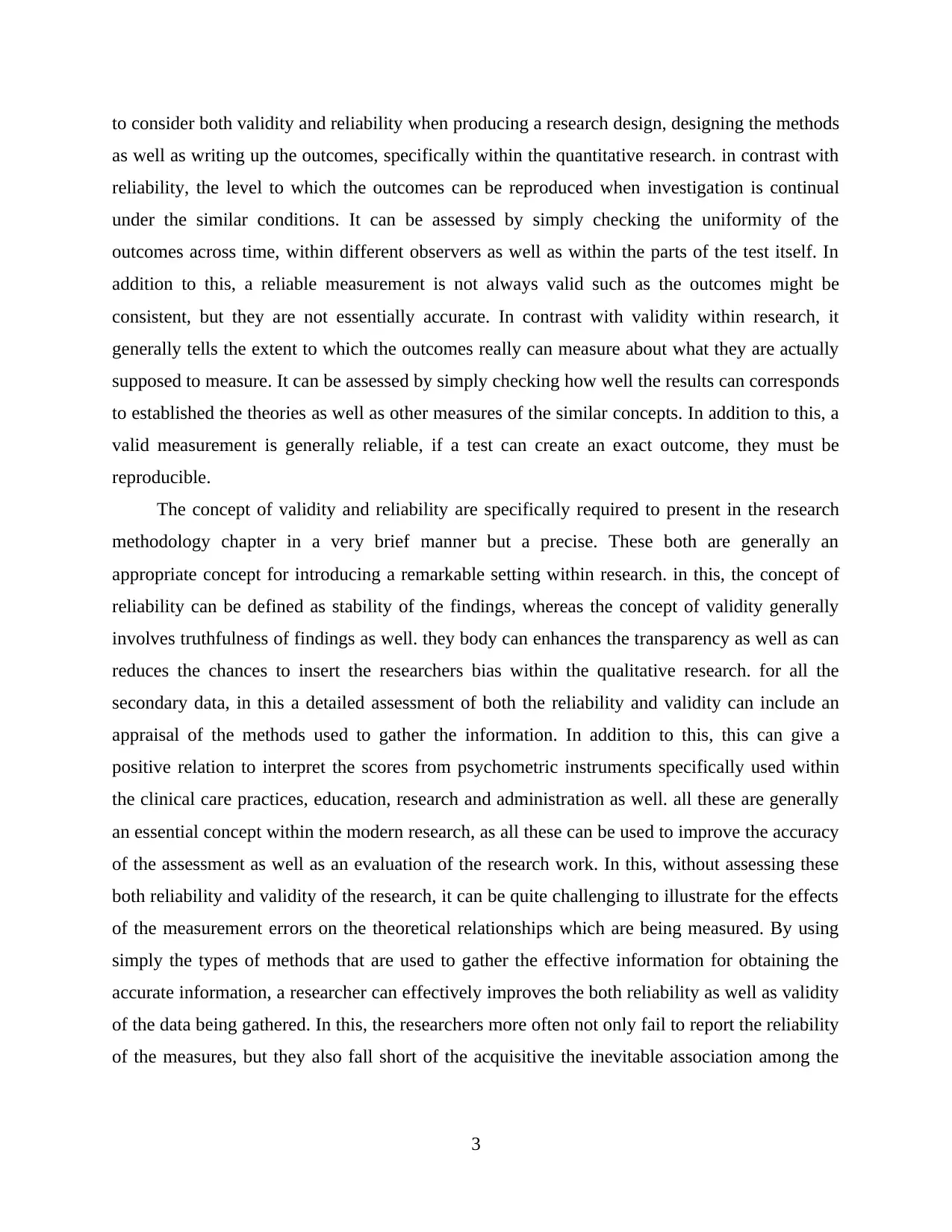
to consider both validity and reliability when producing a research design, designing the methods
as well as writing up the outcomes, specifically within the quantitative research. in contrast with
reliability, the level to which the outcomes can be reproduced when investigation is continual
under the similar conditions. It can be assessed by simply checking the uniformity of the
outcomes across time, within different observers as well as within the parts of the test itself. In
addition to this, a reliable measurement is not always valid such as the outcomes might be
consistent, but they are not essentially accurate. In contrast with validity within research, it
generally tells the extent to which the outcomes really can measure about what they are actually
supposed to measure. It can be assessed by simply checking how well the results can corresponds
to established the theories as well as other measures of the similar concepts. In addition to this, a
valid measurement is generally reliable, if a test can create an exact outcome, they must be
reproducible.
The concept of validity and reliability are specifically required to present in the research
methodology chapter in a very brief manner but a precise. These both are generally an
appropriate concept for introducing a remarkable setting within research. in this, the concept of
reliability can be defined as stability of the findings, whereas the concept of validity generally
involves truthfulness of findings as well. they body can enhances the transparency as well as can
reduces the chances to insert the researchers bias within the qualitative research. for all the
secondary data, in this a detailed assessment of both the reliability and validity can include an
appraisal of the methods used to gather the information. In addition to this, this can give a
positive relation to interpret the scores from psychometric instruments specifically used within
the clinical care practices, education, research and administration as well. all these are generally
an essential concept within the modern research, as all these can be used to improve the accuracy
of the assessment as well as an evaluation of the research work. In this, without assessing these
both reliability and validity of the research, it can be quite challenging to illustrate for the effects
of the measurement errors on the theoretical relationships which are being measured. By using
simply the types of methods that are used to gather the effective information for obtaining the
accurate information, a researcher can effectively improves the both reliability as well as validity
of the data being gathered. In this, the researchers more often not only fail to report the reliability
of the measures, but they also fall short of the acquisitive the inevitable association among the
3
as well as writing up the outcomes, specifically within the quantitative research. in contrast with
reliability, the level to which the outcomes can be reproduced when investigation is continual
under the similar conditions. It can be assessed by simply checking the uniformity of the
outcomes across time, within different observers as well as within the parts of the test itself. In
addition to this, a reliable measurement is not always valid such as the outcomes might be
consistent, but they are not essentially accurate. In contrast with validity within research, it
generally tells the extent to which the outcomes really can measure about what they are actually
supposed to measure. It can be assessed by simply checking how well the results can corresponds
to established the theories as well as other measures of the similar concepts. In addition to this, a
valid measurement is generally reliable, if a test can create an exact outcome, they must be
reproducible.
The concept of validity and reliability are specifically required to present in the research
methodology chapter in a very brief manner but a precise. These both are generally an
appropriate concept for introducing a remarkable setting within research. in this, the concept of
reliability can be defined as stability of the findings, whereas the concept of validity generally
involves truthfulness of findings as well. they body can enhances the transparency as well as can
reduces the chances to insert the researchers bias within the qualitative research. for all the
secondary data, in this a detailed assessment of both the reliability and validity can include an
appraisal of the methods used to gather the information. In addition to this, this can give a
positive relation to interpret the scores from psychometric instruments specifically used within
the clinical care practices, education, research and administration as well. all these are generally
an essential concept within the modern research, as all these can be used to improve the accuracy
of the assessment as well as an evaluation of the research work. In this, without assessing these
both reliability and validity of the research, it can be quite challenging to illustrate for the effects
of the measurement errors on the theoretical relationships which are being measured. By using
simply the types of methods that are used to gather the effective information for obtaining the
accurate information, a researcher can effectively improves the both reliability as well as validity
of the data being gathered. In this, the researchers more often not only fail to report the reliability
of the measures, but they also fall short of the acquisitive the inevitable association among the
3
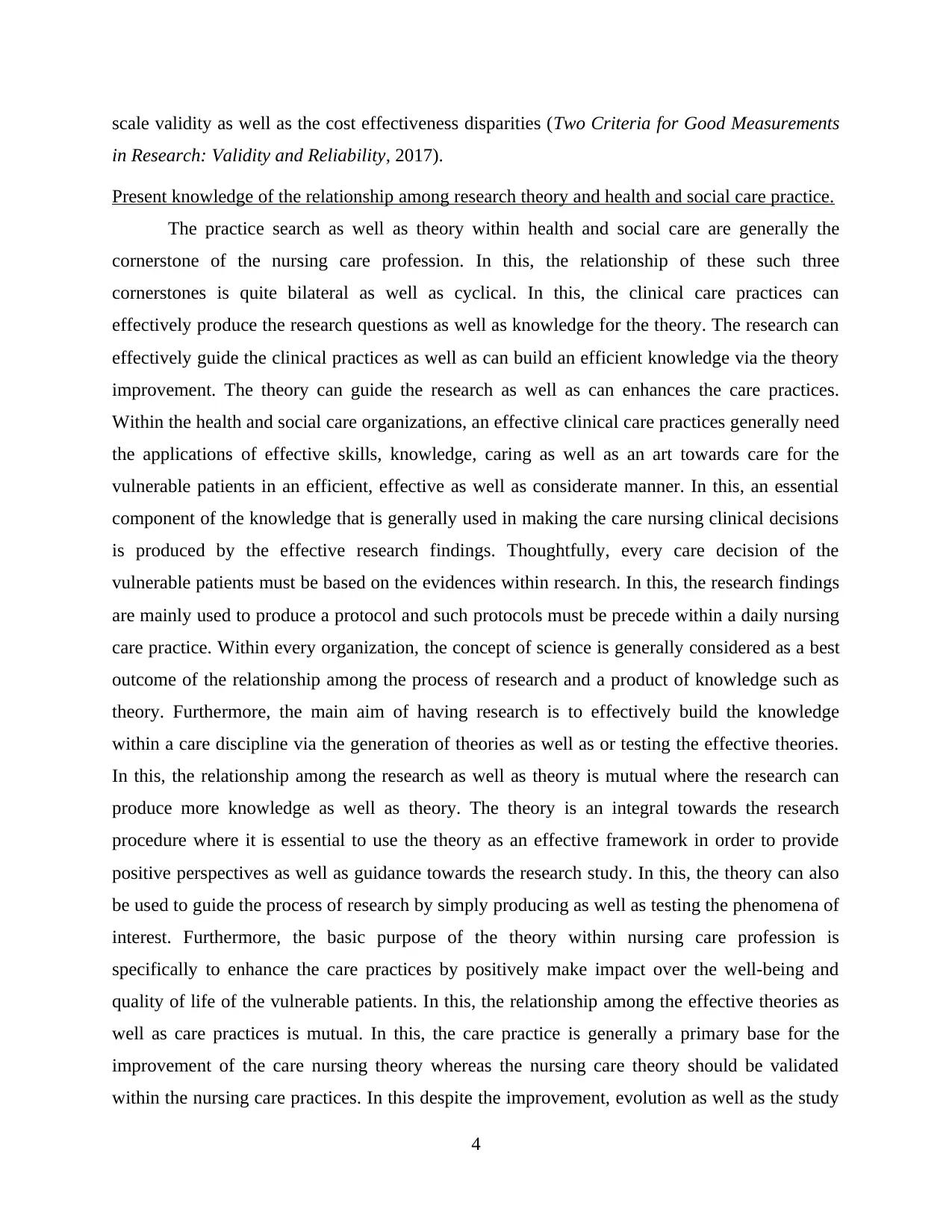
scale validity as well as the cost effectiveness disparities (Two Criteria for Good Measurements
in Research: Validity and Reliability, 2017).
Present knowledge of the relationship among research theory and health and social care practice.
The practice search as well as theory within health and social care are generally the
cornerstone of the nursing care profession. In this, the relationship of these such three
cornerstones is quite bilateral as well as cyclical. In this, the clinical care practices can
effectively produce the research questions as well as knowledge for the theory. The research can
effectively guide the clinical practices as well as can build an efficient knowledge via the theory
improvement. The theory can guide the research as well as can enhances the care practices.
Within the health and social care organizations, an effective clinical care practices generally need
the applications of effective skills, knowledge, caring as well as an art towards care for the
vulnerable patients in an efficient, effective as well as considerate manner. In this, an essential
component of the knowledge that is generally used in making the care nursing clinical decisions
is produced by the effective research findings. Thoughtfully, every care decision of the
vulnerable patients must be based on the evidences within research. In this, the research findings
are mainly used to produce a protocol and such protocols must be precede within a daily nursing
care practice. Within every organization, the concept of science is generally considered as a best
outcome of the relationship among the process of research and a product of knowledge such as
theory. Furthermore, the main aim of having research is to effectively build the knowledge
within a care discipline via the generation of theories as well as or testing the effective theories.
In this, the relationship among the research as well as theory is mutual where the research can
produce more knowledge as well as theory. The theory is an integral towards the research
procedure where it is essential to use the theory as an effective framework in order to provide
positive perspectives as well as guidance towards the research study. In this, the theory can also
be used to guide the process of research by simply producing as well as testing the phenomena of
interest. Furthermore, the basic purpose of the theory within nursing care profession is
specifically to enhance the care practices by positively make impact over the well-being and
quality of life of the vulnerable patients. In this, the relationship among the effective theories as
well as care practices is mutual. In this, the care practice is generally a primary base for the
improvement of the care nursing theory whereas the nursing care theory should be validated
within the nursing care practices. In this despite the improvement, evolution as well as the study
4
in Research: Validity and Reliability, 2017).
Present knowledge of the relationship among research theory and health and social care practice.
The practice search as well as theory within health and social care are generally the
cornerstone of the nursing care profession. In this, the relationship of these such three
cornerstones is quite bilateral as well as cyclical. In this, the clinical care practices can
effectively produce the research questions as well as knowledge for the theory. The research can
effectively guide the clinical practices as well as can build an efficient knowledge via the theory
improvement. The theory can guide the research as well as can enhances the care practices.
Within the health and social care organizations, an effective clinical care practices generally need
the applications of effective skills, knowledge, caring as well as an art towards care for the
vulnerable patients in an efficient, effective as well as considerate manner. In this, an essential
component of the knowledge that is generally used in making the care nursing clinical decisions
is produced by the effective research findings. Thoughtfully, every care decision of the
vulnerable patients must be based on the evidences within research. In this, the research findings
are mainly used to produce a protocol and such protocols must be precede within a daily nursing
care practice. Within every organization, the concept of science is generally considered as a best
outcome of the relationship among the process of research and a product of knowledge such as
theory. Furthermore, the main aim of having research is to effectively build the knowledge
within a care discipline via the generation of theories as well as or testing the effective theories.
In this, the relationship among the research as well as theory is mutual where the research can
produce more knowledge as well as theory. The theory is an integral towards the research
procedure where it is essential to use the theory as an effective framework in order to provide
positive perspectives as well as guidance towards the research study. In this, the theory can also
be used to guide the process of research by simply producing as well as testing the phenomena of
interest. Furthermore, the basic purpose of the theory within nursing care profession is
specifically to enhance the care practices by positively make impact over the well-being and
quality of life of the vulnerable patients. In this, the relationship among the effective theories as
well as care practices is mutual. In this, the care practice is generally a primary base for the
improvement of the care nursing theory whereas the nursing care theory should be validated
within the nursing care practices. In this despite the improvement, evolution as well as the study
4
⊘ This is a preview!⊘
Do you want full access?
Subscribe today to unlock all pages.

Trusted by 1+ million students worldwide
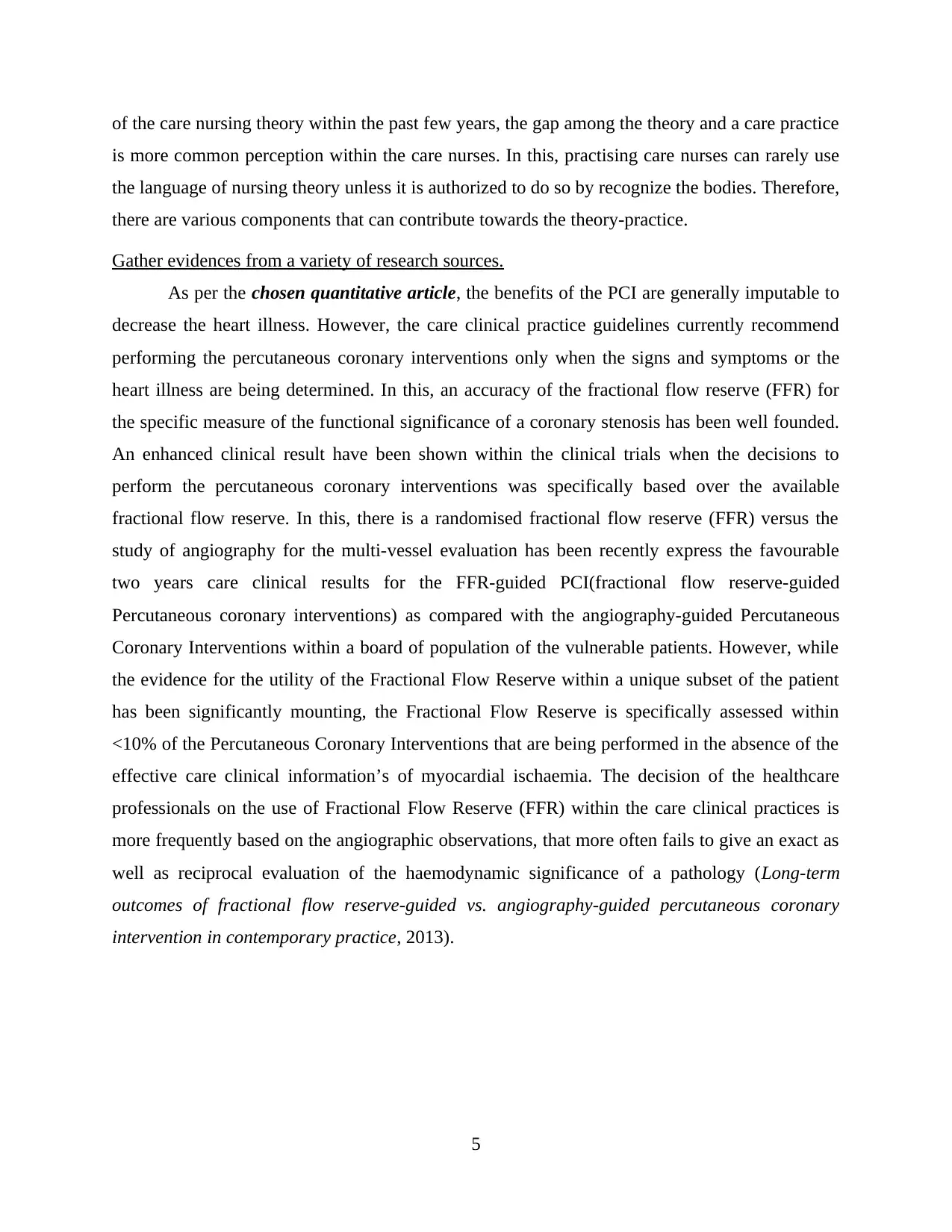
of the care nursing theory within the past few years, the gap among the theory and a care practice
is more common perception within the care nurses. In this, practising care nurses can rarely use
the language of nursing theory unless it is authorized to do so by recognize the bodies. Therefore,
there are various components that can contribute towards the theory-practice.
Gather evidences from a variety of research sources.
As per the chosen quantitative article, the benefits of the PCI are generally imputable to
decrease the heart illness. However, the care clinical practice guidelines currently recommend
performing the percutaneous coronary interventions only when the signs and symptoms or the
heart illness are being determined. In this, an accuracy of the fractional flow reserve (FFR) for
the specific measure of the functional significance of a coronary stenosis has been well founded.
An enhanced clinical result have been shown within the clinical trials when the decisions to
perform the percutaneous coronary interventions was specifically based over the available
fractional flow reserve. In this, there is a randomised fractional flow reserve (FFR) versus the
study of angiography for the multi-vessel evaluation has been recently express the favourable
two years care clinical results for the FFR-guided PCI(fractional flow reserve-guided
Percutaneous coronary interventions) as compared with the angiography-guided Percutaneous
Coronary Interventions within a board of population of the vulnerable patients. However, while
the evidence for the utility of the Fractional Flow Reserve within a unique subset of the patient
has been significantly mounting, the Fractional Flow Reserve is specifically assessed within
<10% of the Percutaneous Coronary Interventions that are being performed in the absence of the
effective care clinical information’s of myocardial ischaemia. The decision of the healthcare
professionals on the use of Fractional Flow Reserve (FFR) within the care clinical practices is
more frequently based on the angiographic observations, that more often fails to give an exact as
well as reciprocal evaluation of the haemodynamic significance of a pathology (Long-term
outcomes of fractional flow reserve-guided vs. angiography-guided percutaneous coronary
intervention in contemporary practice, 2013).
5
is more common perception within the care nurses. In this, practising care nurses can rarely use
the language of nursing theory unless it is authorized to do so by recognize the bodies. Therefore,
there are various components that can contribute towards the theory-practice.
Gather evidences from a variety of research sources.
As per the chosen quantitative article, the benefits of the PCI are generally imputable to
decrease the heart illness. However, the care clinical practice guidelines currently recommend
performing the percutaneous coronary interventions only when the signs and symptoms or the
heart illness are being determined. In this, an accuracy of the fractional flow reserve (FFR) for
the specific measure of the functional significance of a coronary stenosis has been well founded.
An enhanced clinical result have been shown within the clinical trials when the decisions to
perform the percutaneous coronary interventions was specifically based over the available
fractional flow reserve. In this, there is a randomised fractional flow reserve (FFR) versus the
study of angiography for the multi-vessel evaluation has been recently express the favourable
two years care clinical results for the FFR-guided PCI(fractional flow reserve-guided
Percutaneous coronary interventions) as compared with the angiography-guided Percutaneous
Coronary Interventions within a board of population of the vulnerable patients. However, while
the evidence for the utility of the Fractional Flow Reserve within a unique subset of the patient
has been significantly mounting, the Fractional Flow Reserve is specifically assessed within
<10% of the Percutaneous Coronary Interventions that are being performed in the absence of the
effective care clinical information’s of myocardial ischaemia. The decision of the healthcare
professionals on the use of Fractional Flow Reserve (FFR) within the care clinical practices is
more frequently based on the angiographic observations, that more often fails to give an exact as
well as reciprocal evaluation of the haemodynamic significance of a pathology (Long-term
outcomes of fractional flow reserve-guided vs. angiography-guided percutaneous coronary
intervention in contemporary practice, 2013).
5
Paraphrase This Document
Need a fresh take? Get an instant paraphrase of this document with our AI Paraphraser
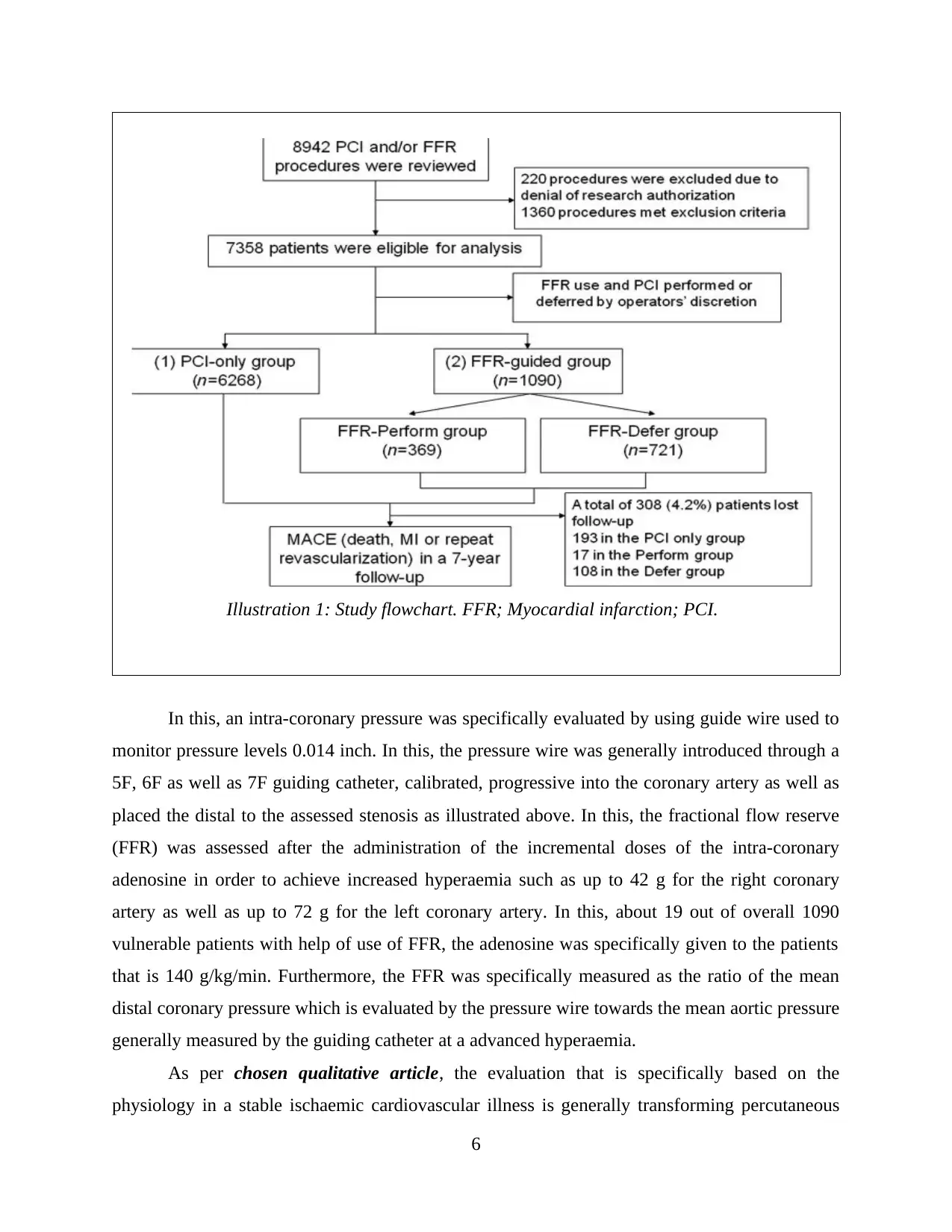
In this, an intra-coronary pressure was specifically evaluated by using guide wire used to
monitor pressure levels 0.014 inch. In this, the pressure wire was generally introduced through a
5F, 6F as well as 7F guiding catheter, calibrated, progressive into the coronary artery as well as
placed the distal to the assessed stenosis as illustrated above. In this, the fractional flow reserve
(FFR) was assessed after the administration of the incremental doses of the intra-coronary
adenosine in order to achieve increased hyperaemia such as up to 42 g for the right coronary
artery as well as up to 72 g for the left coronary artery. In this, about 19 out of overall 1090
vulnerable patients with help of use of FFR, the adenosine was specifically given to the patients
that is 140 g/kg/min. Furthermore, the FFR was specifically measured as the ratio of the mean
distal coronary pressure which is evaluated by the pressure wire towards the mean aortic pressure
generally measured by the guiding catheter at a advanced hyperaemia.
As per chosen qualitative article, the evaluation that is specifically based on the
physiology in a stable ischaemic cardiovascular illness is generally transforming percutaneous
6
Illustration 1: Study flowchart. FFR; Myocardial infarction; PCI.
monitor pressure levels 0.014 inch. In this, the pressure wire was generally introduced through a
5F, 6F as well as 7F guiding catheter, calibrated, progressive into the coronary artery as well as
placed the distal to the assessed stenosis as illustrated above. In this, the fractional flow reserve
(FFR) was assessed after the administration of the incremental doses of the intra-coronary
adenosine in order to achieve increased hyperaemia such as up to 42 g for the right coronary
artery as well as up to 72 g for the left coronary artery. In this, about 19 out of overall 1090
vulnerable patients with help of use of FFR, the adenosine was specifically given to the patients
that is 140 g/kg/min. Furthermore, the FFR was specifically measured as the ratio of the mean
distal coronary pressure which is evaluated by the pressure wire towards the mean aortic pressure
generally measured by the guiding catheter at a advanced hyperaemia.
As per chosen qualitative article, the evaluation that is specifically based on the
physiology in a stable ischaemic cardiovascular illness is generally transforming percutaneous
6
Illustration 1: Study flowchart. FFR; Myocardial infarction; PCI.
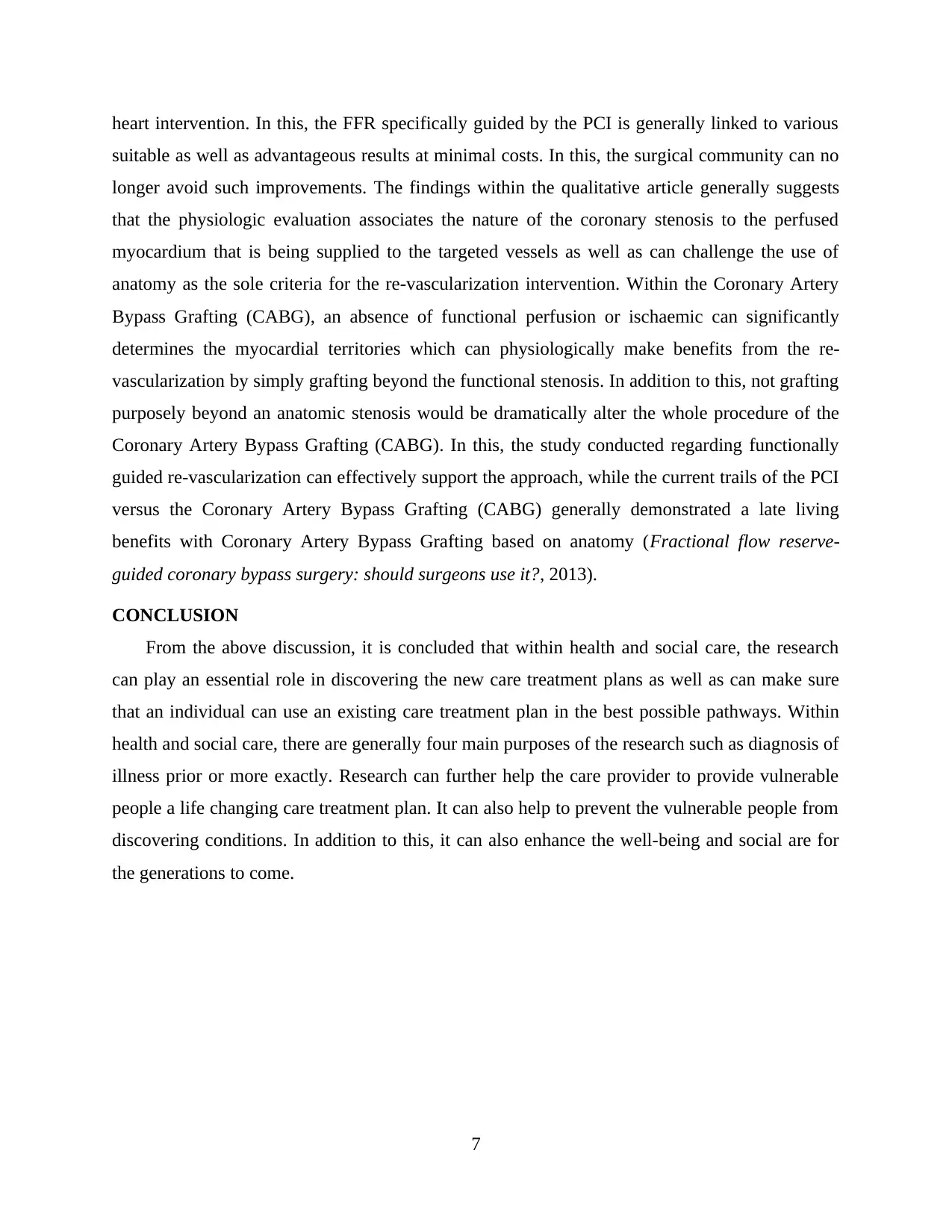
heart intervention. In this, the FFR specifically guided by the PCI is generally linked to various
suitable as well as advantageous results at minimal costs. In this, the surgical community can no
longer avoid such improvements. The findings within the qualitative article generally suggests
that the physiologic evaluation associates the nature of the coronary stenosis to the perfused
myocardium that is being supplied to the targeted vessels as well as can challenge the use of
anatomy as the sole criteria for the re-vascularization intervention. Within the Coronary Artery
Bypass Grafting (CABG), an absence of functional perfusion or ischaemic can significantly
determines the myocardial territories which can physiologically make benefits from the re-
vascularization by simply grafting beyond the functional stenosis. In addition to this, not grafting
purposely beyond an anatomic stenosis would be dramatically alter the whole procedure of the
Coronary Artery Bypass Grafting (CABG). In this, the study conducted regarding functionally
guided re-vascularization can effectively support the approach, while the current trails of the PCI
versus the Coronary Artery Bypass Grafting (CABG) generally demonstrated a late living
benefits with Coronary Artery Bypass Grafting based on anatomy (Fractional flow reserve-
guided coronary bypass surgery: should surgeons use it?, 2013).
CONCLUSION
From the above discussion, it is concluded that within health and social care, the research
can play an essential role in discovering the new care treatment plans as well as can make sure
that an individual can use an existing care treatment plan in the best possible pathways. Within
health and social care, there are generally four main purposes of the research such as diagnosis of
illness prior or more exactly. Research can further help the care provider to provide vulnerable
people a life changing care treatment plan. It can also help to prevent the vulnerable people from
discovering conditions. In addition to this, it can also enhance the well-being and social are for
the generations to come.
7
suitable as well as advantageous results at minimal costs. In this, the surgical community can no
longer avoid such improvements. The findings within the qualitative article generally suggests
that the physiologic evaluation associates the nature of the coronary stenosis to the perfused
myocardium that is being supplied to the targeted vessels as well as can challenge the use of
anatomy as the sole criteria for the re-vascularization intervention. Within the Coronary Artery
Bypass Grafting (CABG), an absence of functional perfusion or ischaemic can significantly
determines the myocardial territories which can physiologically make benefits from the re-
vascularization by simply grafting beyond the functional stenosis. In addition to this, not grafting
purposely beyond an anatomic stenosis would be dramatically alter the whole procedure of the
Coronary Artery Bypass Grafting (CABG). In this, the study conducted regarding functionally
guided re-vascularization can effectively support the approach, while the current trails of the PCI
versus the Coronary Artery Bypass Grafting (CABG) generally demonstrated a late living
benefits with Coronary Artery Bypass Grafting based on anatomy (Fractional flow reserve-
guided coronary bypass surgery: should surgeons use it?, 2013).
CONCLUSION
From the above discussion, it is concluded that within health and social care, the research
can play an essential role in discovering the new care treatment plans as well as can make sure
that an individual can use an existing care treatment plan in the best possible pathways. Within
health and social care, there are generally four main purposes of the research such as diagnosis of
illness prior or more exactly. Research can further help the care provider to provide vulnerable
people a life changing care treatment plan. It can also help to prevent the vulnerable people from
discovering conditions. In addition to this, it can also enhance the well-being and social are for
the generations to come.
7
⊘ This is a preview!⊘
Do you want full access?
Subscribe today to unlock all pages.

Trusted by 1+ million students worldwide
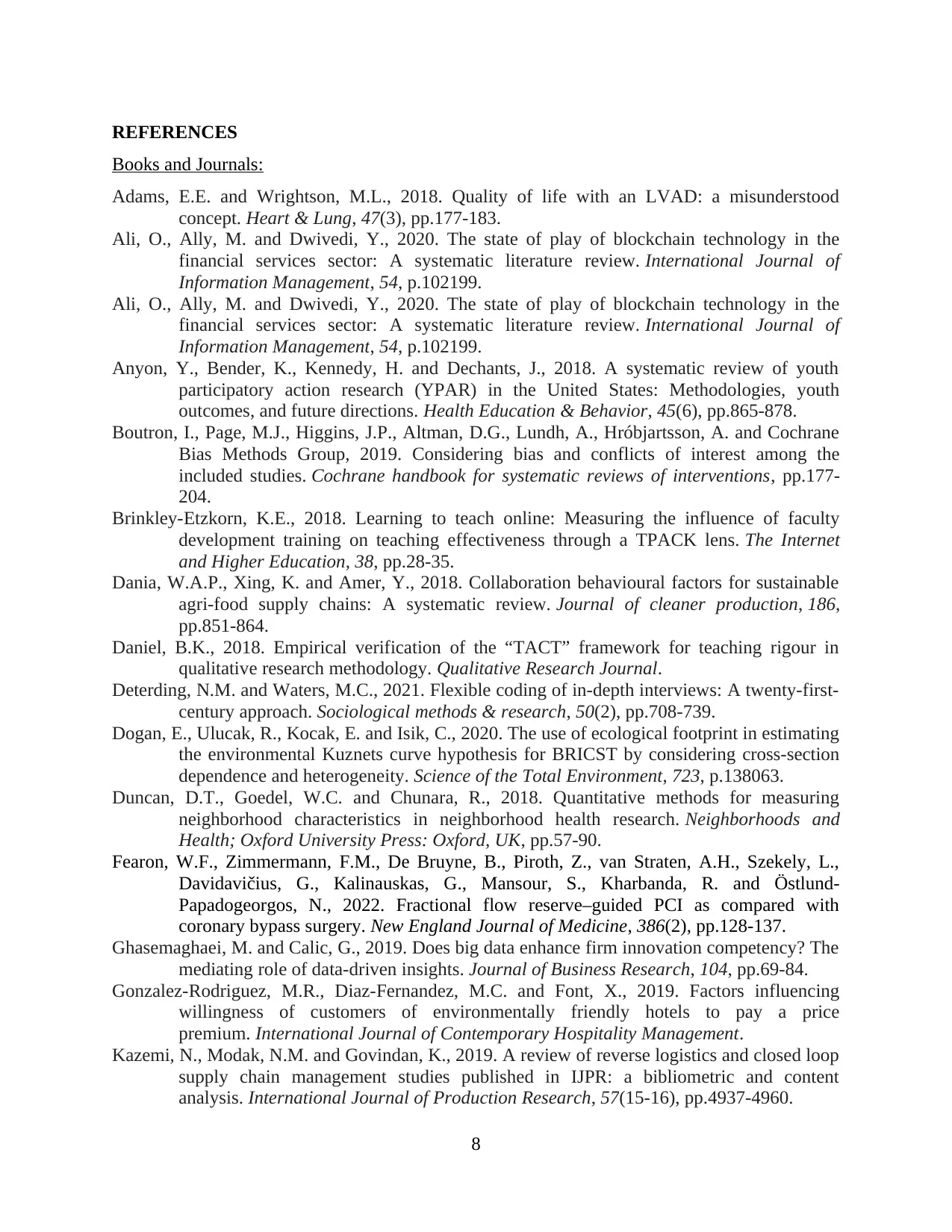
REFERENCES
Books and Journals:
Adams, E.E. and Wrightson, M.L., 2018. Quality of life with an LVAD: a misunderstood
concept. Heart & Lung, 47(3), pp.177-183.
Ali, O., Ally, M. and Dwivedi, Y., 2020. The state of play of blockchain technology in the
financial services sector: A systematic literature review. International Journal of
Information Management, 54, p.102199.
Ali, O., Ally, M. and Dwivedi, Y., 2020. The state of play of blockchain technology in the
financial services sector: A systematic literature review. International Journal of
Information Management, 54, p.102199.
Anyon, Y., Bender, K., Kennedy, H. and Dechants, J., 2018. A systematic review of youth
participatory action research (YPAR) in the United States: Methodologies, youth
outcomes, and future directions. Health Education & Behavior, 45(6), pp.865-878.
Boutron, I., Page, M.J., Higgins, J.P., Altman, D.G., Lundh, A., Hróbjartsson, A. and Cochrane
Bias Methods Group, 2019. Considering bias and conflicts of interest among the
included studies. Cochrane handbook for systematic reviews of interventions, pp.177-
204.
Brinkley-Etzkorn, K.E., 2018. Learning to teach online: Measuring the influence of faculty
development training on teaching effectiveness through a TPACK lens. The Internet
and Higher Education, 38, pp.28-35.
Dania, W.A.P., Xing, K. and Amer, Y., 2018. Collaboration behavioural factors for sustainable
agri-food supply chains: A systematic review. Journal of cleaner production, 186,
pp.851-864.
Daniel, B.K., 2018. Empirical verification of the “TACT” framework for teaching rigour in
qualitative research methodology. Qualitative Research Journal.
Deterding, N.M. and Waters, M.C., 2021. Flexible coding of in-depth interviews: A twenty-first-
century approach. Sociological methods & research, 50(2), pp.708-739.
Dogan, E., Ulucak, R., Kocak, E. and Isik, C., 2020. The use of ecological footprint in estimating
the environmental Kuznets curve hypothesis for BRICST by considering cross-section
dependence and heterogeneity. Science of the Total Environment, 723, p.138063.
Duncan, D.T., Goedel, W.C. and Chunara, R., 2018. Quantitative methods for measuring
neighborhood characteristics in neighborhood health research. Neighborhoods and
Health; Oxford University Press: Oxford, UK, pp.57-90.
Fearon, W.F., Zimmermann, F.M., De Bruyne, B., Piroth, Z., van Straten, A.H., Szekely, L.,
Davidavičius, G., Kalinauskas, G., Mansour, S., Kharbanda, R. and Östlund-
Papadogeorgos, N., 2022. Fractional flow reserve–guided PCI as compared with
coronary bypass surgery. New England Journal of Medicine, 386(2), pp.128-137.
Ghasemaghaei, M. and Calic, G., 2019. Does big data enhance firm innovation competency? The
mediating role of data-driven insights. Journal of Business Research, 104, pp.69-84.
Gonzalez-Rodriguez, M.R., Diaz-Fernandez, M.C. and Font, X., 2019. Factors influencing
willingness of customers of environmentally friendly hotels to pay a price
premium. International Journal of Contemporary Hospitality Management.
Kazemi, N., Modak, N.M. and Govindan, K., 2019. A review of reverse logistics and closed loop
supply chain management studies published in IJPR: a bibliometric and content
analysis. International Journal of Production Research, 57(15-16), pp.4937-4960.
8
Books and Journals:
Adams, E.E. and Wrightson, M.L., 2018. Quality of life with an LVAD: a misunderstood
concept. Heart & Lung, 47(3), pp.177-183.
Ali, O., Ally, M. and Dwivedi, Y., 2020. The state of play of blockchain technology in the
financial services sector: A systematic literature review. International Journal of
Information Management, 54, p.102199.
Ali, O., Ally, M. and Dwivedi, Y., 2020. The state of play of blockchain technology in the
financial services sector: A systematic literature review. International Journal of
Information Management, 54, p.102199.
Anyon, Y., Bender, K., Kennedy, H. and Dechants, J., 2018. A systematic review of youth
participatory action research (YPAR) in the United States: Methodologies, youth
outcomes, and future directions. Health Education & Behavior, 45(6), pp.865-878.
Boutron, I., Page, M.J., Higgins, J.P., Altman, D.G., Lundh, A., Hróbjartsson, A. and Cochrane
Bias Methods Group, 2019. Considering bias and conflicts of interest among the
included studies. Cochrane handbook for systematic reviews of interventions, pp.177-
204.
Brinkley-Etzkorn, K.E., 2018. Learning to teach online: Measuring the influence of faculty
development training on teaching effectiveness through a TPACK lens. The Internet
and Higher Education, 38, pp.28-35.
Dania, W.A.P., Xing, K. and Amer, Y., 2018. Collaboration behavioural factors for sustainable
agri-food supply chains: A systematic review. Journal of cleaner production, 186,
pp.851-864.
Daniel, B.K., 2018. Empirical verification of the “TACT” framework for teaching rigour in
qualitative research methodology. Qualitative Research Journal.
Deterding, N.M. and Waters, M.C., 2021. Flexible coding of in-depth interviews: A twenty-first-
century approach. Sociological methods & research, 50(2), pp.708-739.
Dogan, E., Ulucak, R., Kocak, E. and Isik, C., 2020. The use of ecological footprint in estimating
the environmental Kuznets curve hypothesis for BRICST by considering cross-section
dependence and heterogeneity. Science of the Total Environment, 723, p.138063.
Duncan, D.T., Goedel, W.C. and Chunara, R., 2018. Quantitative methods for measuring
neighborhood characteristics in neighborhood health research. Neighborhoods and
Health; Oxford University Press: Oxford, UK, pp.57-90.
Fearon, W.F., Zimmermann, F.M., De Bruyne, B., Piroth, Z., van Straten, A.H., Szekely, L.,
Davidavičius, G., Kalinauskas, G., Mansour, S., Kharbanda, R. and Östlund-
Papadogeorgos, N., 2022. Fractional flow reserve–guided PCI as compared with
coronary bypass surgery. New England Journal of Medicine, 386(2), pp.128-137.
Ghasemaghaei, M. and Calic, G., 2019. Does big data enhance firm innovation competency? The
mediating role of data-driven insights. Journal of Business Research, 104, pp.69-84.
Gonzalez-Rodriguez, M.R., Diaz-Fernandez, M.C. and Font, X., 2019. Factors influencing
willingness of customers of environmentally friendly hotels to pay a price
premium. International Journal of Contemporary Hospitality Management.
Kazemi, N., Modak, N.M. and Govindan, K., 2019. A review of reverse logistics and closed loop
supply chain management studies published in IJPR: a bibliometric and content
analysis. International Journal of Production Research, 57(15-16), pp.4937-4960.
8
Paraphrase This Document
Need a fresh take? Get an instant paraphrase of this document with our AI Paraphraser
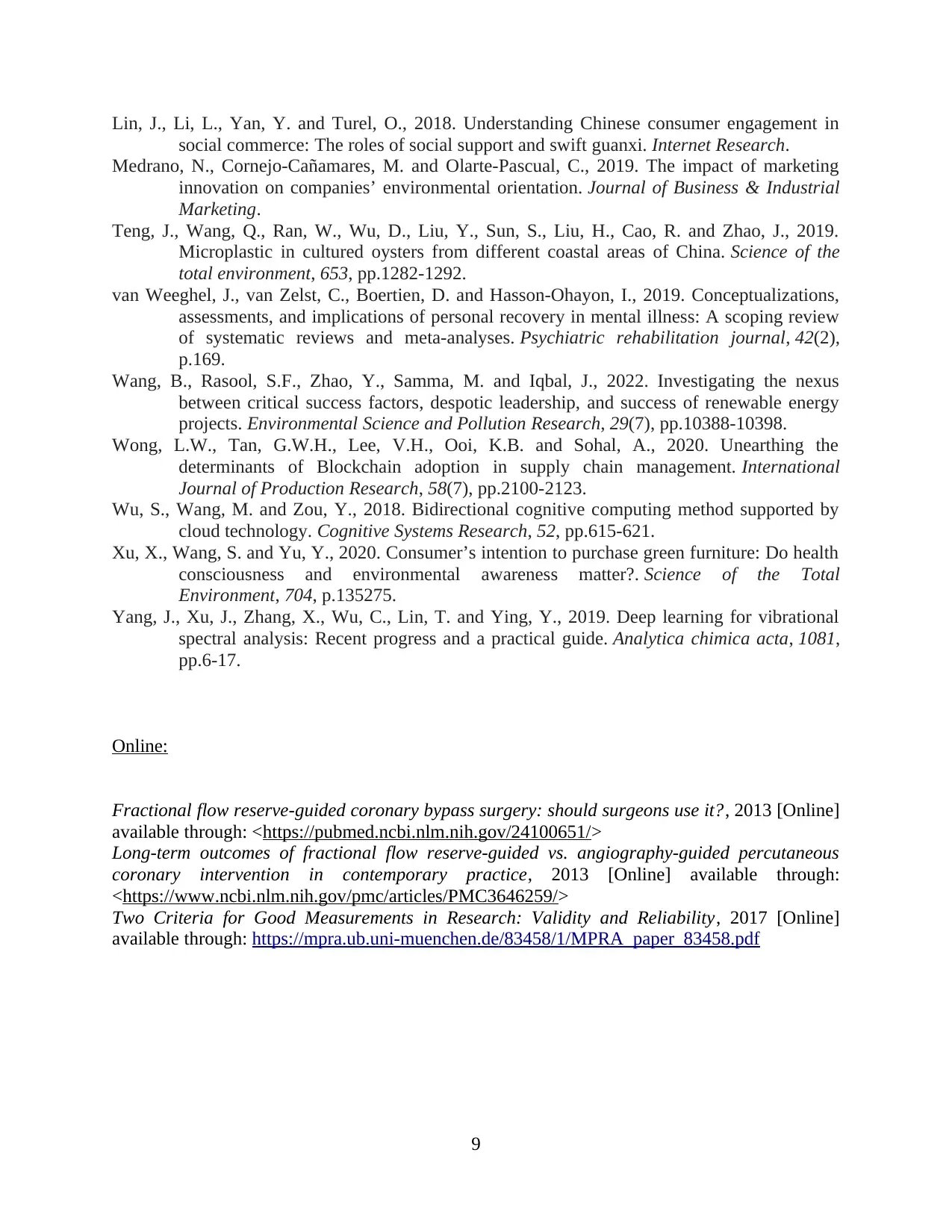
Lin, J., Li, L., Yan, Y. and Turel, O., 2018. Understanding Chinese consumer engagement in
social commerce: The roles of social support and swift guanxi. Internet Research.
Medrano, N., Cornejo-Cañamares, M. and Olarte-Pascual, C., 2019. The impact of marketing
innovation on companies’ environmental orientation. Journal of Business & Industrial
Marketing.
Teng, J., Wang, Q., Ran, W., Wu, D., Liu, Y., Sun, S., Liu, H., Cao, R. and Zhao, J., 2019.
Microplastic in cultured oysters from different coastal areas of China. Science of the
total environment, 653, pp.1282-1292.
van Weeghel, J., van Zelst, C., Boertien, D. and Hasson-Ohayon, I., 2019. Conceptualizations,
assessments, and implications of personal recovery in mental illness: A scoping review
of systematic reviews and meta-analyses. Psychiatric rehabilitation journal, 42(2),
p.169.
Wang, B., Rasool, S.F., Zhao, Y., Samma, M. and Iqbal, J., 2022. Investigating the nexus
between critical success factors, despotic leadership, and success of renewable energy
projects. Environmental Science and Pollution Research, 29(7), pp.10388-10398.
Wong, L.W., Tan, G.W.H., Lee, V.H., Ooi, K.B. and Sohal, A., 2020. Unearthing the
determinants of Blockchain adoption in supply chain management. International
Journal of Production Research, 58(7), pp.2100-2123.
Wu, S., Wang, M. and Zou, Y., 2018. Bidirectional cognitive computing method supported by
cloud technology. Cognitive Systems Research, 52, pp.615-621.
Xu, X., Wang, S. and Yu, Y., 2020. Consumer’s intention to purchase green furniture: Do health
consciousness and environmental awareness matter?. Science of the Total
Environment, 704, p.135275.
Yang, J., Xu, J., Zhang, X., Wu, C., Lin, T. and Ying, Y., 2019. Deep learning for vibrational
spectral analysis: Recent progress and a practical guide. Analytica chimica acta, 1081,
pp.6-17.
Online:
Fractional flow reserve-guided coronary bypass surgery: should surgeons use it?, 2013 [Online]
available through: <https://pubmed.ncbi.nlm.nih.gov/24100651/>
Long-term outcomes of fractional flow reserve-guided vs. angiography-guided percutaneous
coronary intervention in contemporary practice, 2013 [Online] available through:
<https://www.ncbi.nlm.nih.gov/pmc/articles/PMC3646259/>
Two Criteria for Good Measurements in Research: Validity and Reliability, 2017 [Online]
available through: https://mpra.ub.uni-muenchen.de/83458/1/MPRA_paper_83458.pdf
9
social commerce: The roles of social support and swift guanxi. Internet Research.
Medrano, N., Cornejo-Cañamares, M. and Olarte-Pascual, C., 2019. The impact of marketing
innovation on companies’ environmental orientation. Journal of Business & Industrial
Marketing.
Teng, J., Wang, Q., Ran, W., Wu, D., Liu, Y., Sun, S., Liu, H., Cao, R. and Zhao, J., 2019.
Microplastic in cultured oysters from different coastal areas of China. Science of the
total environment, 653, pp.1282-1292.
van Weeghel, J., van Zelst, C., Boertien, D. and Hasson-Ohayon, I., 2019. Conceptualizations,
assessments, and implications of personal recovery in mental illness: A scoping review
of systematic reviews and meta-analyses. Psychiatric rehabilitation journal, 42(2),
p.169.
Wang, B., Rasool, S.F., Zhao, Y., Samma, M. and Iqbal, J., 2022. Investigating the nexus
between critical success factors, despotic leadership, and success of renewable energy
projects. Environmental Science and Pollution Research, 29(7), pp.10388-10398.
Wong, L.W., Tan, G.W.H., Lee, V.H., Ooi, K.B. and Sohal, A., 2020. Unearthing the
determinants of Blockchain adoption in supply chain management. International
Journal of Production Research, 58(7), pp.2100-2123.
Wu, S., Wang, M. and Zou, Y., 2018. Bidirectional cognitive computing method supported by
cloud technology. Cognitive Systems Research, 52, pp.615-621.
Xu, X., Wang, S. and Yu, Y., 2020. Consumer’s intention to purchase green furniture: Do health
consciousness and environmental awareness matter?. Science of the Total
Environment, 704, p.135275.
Yang, J., Xu, J., Zhang, X., Wu, C., Lin, T. and Ying, Y., 2019. Deep learning for vibrational
spectral analysis: Recent progress and a practical guide. Analytica chimica acta, 1081,
pp.6-17.
Online:
Fractional flow reserve-guided coronary bypass surgery: should surgeons use it?, 2013 [Online]
available through: <https://pubmed.ncbi.nlm.nih.gov/24100651/>
Long-term outcomes of fractional flow reserve-guided vs. angiography-guided percutaneous
coronary intervention in contemporary practice, 2013 [Online] available through:
<https://www.ncbi.nlm.nih.gov/pmc/articles/PMC3646259/>
Two Criteria for Good Measurements in Research: Validity and Reliability, 2017 [Online]
available through: https://mpra.ub.uni-muenchen.de/83458/1/MPRA_paper_83458.pdf
9
1 out of 11
Related Documents
Your All-in-One AI-Powered Toolkit for Academic Success.
+13062052269
info@desklib.com
Available 24*7 on WhatsApp / Email
![[object Object]](/_next/static/media/star-bottom.7253800d.svg)
Unlock your academic potential
Copyright © 2020–2025 A2Z Services. All Rights Reserved. Developed and managed by ZUCOL.




